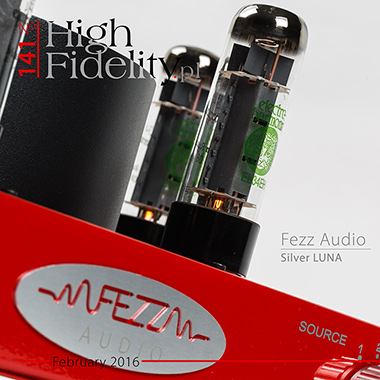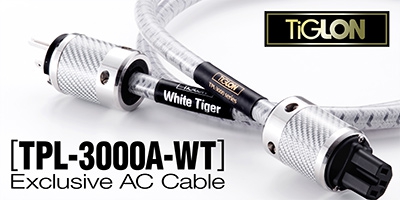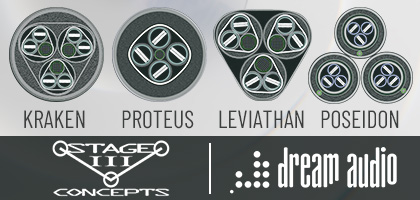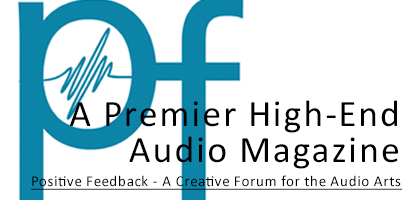No. 257 October 2025
- COVER REVIEW: ANCIENT AUDIO Silver Grand Mono Mk II ⸜ power amplifier • monoblocks » POLAND • Kraków
- KRAKOW SONIC SOCIETY № 153: 30 years of ANCIENT AUDIO » POLAND • Kraków
- FEATURE ⸜ music & technology: HISAO NATSUME presents - In search for the lost great pianism Chopin tradition » part 2 (France) » JAPAN • Tokyo
- REVIEW: AUDIOPHONIQUE Classic AP 300D ⸜ power amplifier » POLAND • Pruszków
- REVIEW: AVATAR AUDIO Holophony No. 1 ⸜ loudspeakers • floor-standing » POLAND • Osowicze
- REVIEW: DIVALDI Gold PA One ⸜ integrated amplifier » POLAND • Kraków
- REVIEW: J.SIKORA Aspire ⸜ turntable (deck + tonearm) » POLAND • Lublin
- REVIEW: MB AUDIO CABLE Silver ⸜ analog interconnect ⸜ RCA » POLAND • Turza Śląska
- REVIEW: XACT N1 ⸜ LAN switch » POLAND • Wrocław


|

|
|
A WISH LIST
Sources 
I think that I don't have to convince anybody today that the future of our hobby lays in digital audio, in zeros and ones. Digital sources, relieved of the burden of physical mediums have already dominated the market. We have a chance to witness the last obstacles laying in a way of audio files to the world of high-end fall – there are already some music servers that offer a high end performance, a truly refined sound. The first ones that came to the market looked a lot as CD Players with a large display on the front displaying albums covers and all information about files being played accompanied with some push-buttons allowing the operation of such devices. It has already changed – a music server might be just a box with no display and no manipulators of any sort, as the control is executed using mobile devices like tablets and smart phones via proper apps. So I wish to us all that such devices become as user friendly as possible – operation should very simple. It turns out that sound quality is one thing but creating a user-friendly, intuitive interface is another, harder one. From your emails I gather that many of you value an ease of operation a lot. I think that manufacturers will have to invest a lot of money for interface development – it will take a lot of time and effort but it might be a decisive element for the success or failure of particular product. Sound quality is, of course, also very important. And the biggest issue here is the anonymity of music files. One buys a file without knowing its story – who recorded it, who did the mastering or remastering of the material. So I wish all who listen music using files that Japanese develop a coherent system of information about every music file that will be widely accepted and used. 
Every action causes a reaction – that's physics. A triumphal comeback of vinyl records was a reaction to digital music leaving behind a physical medium (CD). Vinyl is the only physical medium with its sales fast growing every year. Let's be honest about – sound quality offered by this format was not the 'key' factor here. What people wanted was a physical medium, that's why vinyl became so popular again, also among DJs. But since the opportunity arose we, audiophiles, had to hop on the train. Today all large labels release records plus there are many smaller, audiophile ones also releasing albums on vinyl. I would love to see more attention paid to how material for each album is prepared. In a perfect world a remaster would be prepared using original analogue master-tape in a completely analogue system. The whole series of the Beatles mono recordings released last year by EMI is a great prove that it is doable. Unfortunately it is not a perfect world so most of the material is remastered in digital domain, and almost all recordings nowadays are done using digital recorders, usually computers using Pro Tools. Most new vinyl re-issues are based on digital files and not on analogue material. So I can only wish that quality of such digital files and vinyl releases is as good as only possible – it'd be great if labels could use at least hi-res files, like 24 bit and 96 kHz. An album based on such files has a chance to sound really good. Unfortunately most records are based on 16/44,1 material, which is also a case for most Polish releases! Compact Disc and its successor Super Audio CD formats found themselves in a really difficult spot. The more „conservative” audiophiles love vinyl and don't even care for any digital form of music. The 'progressive' ones, who either were or still are fans of vinyl, believe that hi-res files are the future, the successor of physical discs. I wish both these 'parties' well, as vinyl and music files are what drives audio business today, and our whole hobby is based on passion, on drive to perfection, on constant efforts to improve sound quality, which makes it a noble, respectful approach. On the other hand I will not pretend that i don't love CD as this format A.D. 2015 sounds great. |
I also had a chance to listen to many systems build around turntable or music server that sounded poorly so it's not like the choice of one of these two music mediums guaranties always great results. That's nothing but a wishful thinking. 
Considering the above I wish that CD format is still developed, perfected, that Platinum SHM-CD and Ultra HQCD offered even more music. I'd like to add here another 'smaller' wish – I hope that at least some brands notice that a CD format reached such a high quality level that it is worth keeping it alive, that it is worth to create new, high quality CD Players despite opinions of some audiophiles who claim that this is an obsolete format. I'd like to remind them that the same was said about 30 years ago about vinyl. Acoustics 
I started with sources as the most progress in audio is achieved in this area. The other big change to audio systems that is coming are active room acoustic correction systems. The big boom on a home theater market force manufacturers to look for ways to automatically improve user's experience by correcting speakers placement and room's acoustics. Today such tools already reached proper level and they actually do a lot of good for audio systems too. Such room acoustic correction systems already became a part of high-end audio systems with Accuphase DG-58 being a great example (more HERE), but also of mid-priced systems with the latest Arcam stereo receiver SR250 being a good example. At the same time some companies are developing or already offering systems that adjust sound for particular loudspeakers or headphones. Devialet offers a system called SAM, Linn advertise their proprietary solution called Space Optimization. Our Polish Ancient Audio recently presented their P-3 processor (more HERE). I wish that more companies in near future offer such systems to help users improve their experience. I think this might a future of home audio. Such systems can't be really applied to analogue systems – so for those who have them I wish they could take a proper care of room's acoustics. I wish more people paid attention to where and on what their systems are placed as without taking that into consideration they might loose maybe even 40% of the potential of their systems. 
Next 15 years I think that next 15 years will see further development of two parallel trends – a vintage one and a digital one. Both are positive ones. I wish each of you to find your own niche, your own way to enjoy music. May the audio components sound and look better and better. May the analogue systems be truly analogue and digital ones genuinely digital. Let's hope that vinyl and CD/SACD fans are offered wide variety of titles they could chose from, and let's hope that music files fans will be given an opportunity to know how to chose high quality ones. May the tubes glow beautifully for tube-lovers, and may the solid-state devices use silicon of the highest quality for solid-state aficionados. We, at „High Fidelity”, will do our best to provide you information on many interesting devices from every possible market niche. I would also like to wish to us all that music remains the most important part of our hobby and that audio systems never become more important than music. Wojciech Pacuła |
About Us |
We cooperate |
Patrons |
|
Our reviewers regularly contribute to “Enjoy the Music.com”, “Positive-Feedback.com”, “HiFiStatement.net” and “Hi-Fi Choice & Home Cinema. Edycja Polska” . "High Fidelity" is a monthly magazine dedicated to high quality sound. It has been published since May 1st, 2004. Up until October 2008, the magazine was called "High Fidelity OnLine", but since November 2008 it has been registered under the new title. "High Fidelity" is an online magazine, i.e. it is only published on the web. For the last few years it has been published both in Polish and in English. Thanks to our English section, the magazine has now a worldwide reach - statistics show that we have readers from almost every country in the world. Once a year, we prepare a printed edition of one of reviews published online. This unique, limited collector's edition is given to the visitors of the Audio Show in Warsaw, Poland, held in November of each year. For years, "High Fidelity" has been cooperating with other audio magazines, including “Enjoy the Music.com” and “Positive-Feedback.com” in the U.S. and “HiFiStatement.net” in Germany. Our reviews have also been published by “6moons.com”. You can contact any of our contributors by clicking his email address on our CONTACT page. |
 



|
   |
main page | archive | contact | kts
© 2009 HighFidelity, design by PikselStudio,
projektowanie stron www: Indecity







 t's truly surprising how attached we are to symbolic dates. We celebrate their anniversaries, and some round anniversaries like 20, 50 or a 100 years seem even more important and so we celebrate them in an even more special way. All this time it seems like decimal system is somehow special to us. But this time I'm going to take a bit different approach since the first 15 years of the 21st century ended recently. 15 isn't such a 'round' number – some people might associate it with the way we measure time – there is (4x15) 60 minutes in an hour and 60 seconds in a minute. Anyway – 15 years of this century are gone and I'd like to take this opportunity of a 'round' number/date, take a peek into future and create a wish list for years to come. Since what you're reading is an audio and music magazine my wish list is a list of an audiophile.
t's truly surprising how attached we are to symbolic dates. We celebrate their anniversaries, and some round anniversaries like 20, 50 or a 100 years seem even more important and so we celebrate them in an even more special way. All this time it seems like decimal system is somehow special to us. But this time I'm going to take a bit different approach since the first 15 years of the 21st century ended recently. 15 isn't such a 'round' number – some people might associate it with the way we measure time – there is (4x15) 60 minutes in an hour and 60 seconds in a minute. Anyway – 15 years of this century are gone and I'd like to take this opportunity of a 'round' number/date, take a peek into future and create a wish list for years to come. Since what you're reading is an audio and music magazine my wish list is a list of an audiophile.


